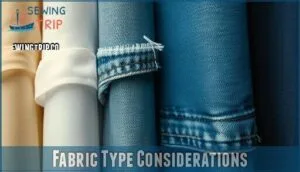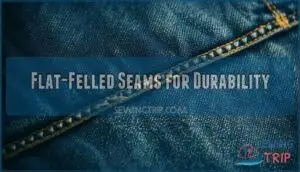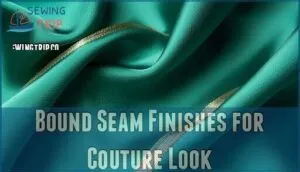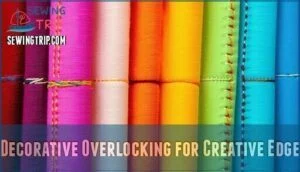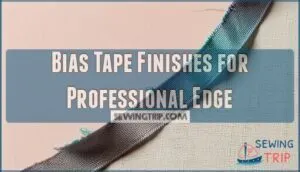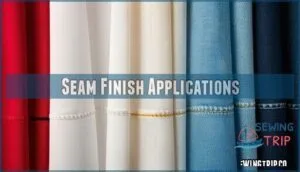This site is supported by our readers. We may earn a commission, at no cost to you, if you purchase through links.
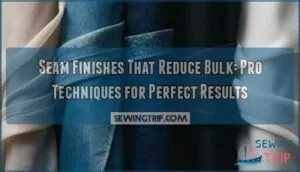
French seams work beautifully for lightweight fabrics, encasing raw edges in a neat package.
Hong Kong seams offer another sleek solution, wrapping edges in bias binding for a couture touch.
For knits, try serging or zigzag stitches that won’t add thickness.
Mock-French seams give you the clean look without multiple fabric layers.
The key is matching your technique to your fabric weight—what works for chiffon won’t suit denim.
Smart seam finishes that reduce bulk transform amateur projects into professional-looking garments.
Each technique has specific fabric partnerships and timing considerations that can make or break your results, highlighting the importance of seam finishes and understanding fabric weight to achieve a clean look.
Table Of Contents
Key Takeaways
- You’ll get professional results by matching your seam finish to fabric weight—French seams work perfectly for lightweight chiffon, while flat-felled seams handle heavyweight denim and canvas without adding bulk.
- You can reduce seam bulk by up to 40% using techniques like grading seam allowances to different lengths, pressing seams open, and choosing mock-French seams for quicker construction on delicate fabrics.
- You’ll achieve couture-quality finishes with Hong Kong seams for sheer fabrics and bias-bound edges for exposed seams, both wrapping raw edges cleanly without creating visible bulk through transparent materials.
- You should trim curved seams, clip notches frequently, and use serged or zigzag stitches for knits since these techniques prevent fraying while maintaining fabric drape and stretch properties.
Reducing Bulk Techniques
Bulky seams can make your garments look homemade and feel uncomfortable, especially around curves and fitted areas.
You’ll master four essential techniques that eliminate excess fabric layers while maintaining professional-quality finishes that won’t add unwanted thickness to your projects, using methods that help maintain a smooth look and feel, which is crucial for fitted areas.
French Seams for Delicates
French seams create the perfect marriage of durability concerns and aesthetic appeal for delicate fabrics like silk and chiffon.
French seams deliver professional elegance while protecting delicate fabrics from fraying—your secret to couture-quality results.
You’ll achieve fabric encasement that prevents fraying while maintaining a sleek appearance.
This lightweight seam finish reduces bulk seams by using a narrow seam allowance twice, encasing raw edges completely.
Discover products for French seams to simplify your sewing, making it your go-to technique for professional-looking garments.
Hong Kong Seams for Sheer Fabrics
Hong Kong seams transform sheer fabric types into couture garment interiors with professional edge enclosure.
You’ll wrap bias tape selection around raw edges, creating minimal bulk stitching that’s visually striking.
This technique works best on straight seams rather than curves, making it perfect for delicate fabrics and lightweight fabrics.
Your reduce bulk seams will look polished and strong.
Mock-French Seams for Lightweight Fabrics
When working with lightweight materials, mock French seams deliver professional results without the fussiness of traditional French seams.
You’ll sew with right sides together first, then fold and stitch again for clean edges.
This technique transforms your delicate fabrics into polished pieces:
- Creates beautifully finished seams that won’t fray
- Reduces bulk better than overlocked edges
- Works perfectly around curves and corners
- Gives sheer fabrics an elegant, couture appearance
- Prevents embarrassing raw edges showing through
For those interested, you can find related product options online.
Pinked Edges for Woven Fabrics
Sharp pinking shears create zigzag edges that naturally prevent fraying in woven fabrics.
You’ll cut along your seam allowance after stitching, creating those distinctive sawtooth patterns.
For extra edge security, add zigzag stitching about 1/8" from the pinked edge.
This simple fray prevention technique works beautifully on most fabric types, giving you professional results without bulk.
Choosing Seam Finishes
You’ll need to match your seam finish to your fabric’s weight, opacity, and how much it frays to get the cleanest results.
Consider how often you’ll wash the garment and whether you want durability or a delicate appearance, since these factors determine which technique will work best for reducing bulk.
Benefits Of Renewable Energy
When choosing seam finishes that reduce bulk, you’re basically investing in renewable techniques for your sewing projects.
Just as renewable energy creates jobs and improves public health, proper seam finishes enhance garment longevity.
Grid modernization parallels how flat seam techniques modernize construction methods.
Climate change demands adaptation, while energy security mirrors how bulk reduction in delicate and lightweight fabrics guarantees your creations endure beautifully.
Challenges In Energy Transition
Policy roadblocks and infrastructure limitations create significant barriers when selecting appropriate seam finishes for bulk reduction.
Investment gaps limit access to specialized equipment needed for flat seam techniques on lightweight fabrics.
Technological hurdles affect public acceptance of newer methods, while traditional approaches remain dominant.
You’ll face similar challenges mastering advanced techniques that require patience and practice.
Innovations In Green Technology
Modern seam finishing mirrors renewable energy storage breakthroughs – both solve efficiency challenges.
Smart grid technology inspires precision in fabric handling, while sustainable materials innovation drives creative solutions.
- Carbon capture advances inform how you’ll trap bulk in seams
- Green transportation solutions guide smooth fabric movement
- Flat seam techniques eliminate unnecessary weight
- Flat felled seam creates streamlined results
- Trimmed seam allowance prevents fabric waste
These reducing bulk methods transform your sewing game.
Fabric Type Considerations
Your fabric’s personality determines which seam finish will give you the cleanest, least bulky results.
You’ll need different approaches for lightweight chiffon versus heavyweight denim, and understanding these differences saves you from frustrating do-overs when seams don’t lay flat.
Lightweight and Delicate Fabrics
Feather-light fabrics demand gentle handling to preserve their fabric drape and prevent damage.
Master delicate fabrics with gentle techniques that honor their ethereal beauty and natural flow.
You’ll find delicate fabrics like chiffon need French seams with trimmed seam allowances to reduce bulk effectively.
These lightweight materials showcase their fabric personality best when you match finishing techniques to their unique characteristics, ensuring fraying prevention while maintaining the ethereal quality that makes them special.
Sheer and Semi-Sheer Fabrics
When working with sheer fabrics, you’ll discover that transparency creates unique challenges requiring special attention to seam visibility.
These delicate fabrics demand finishes that won’t show through or create unsightly bulk.
- Hong Kong seam techniques using bias tape provide the cleanest finish for sheer materials
- Fabric Stabilization through proper pressing prevents stretching during construction
- Seam Reinforcement with French seams guarantees durability without compromising the fabric’s natural drape
Heavyweight and Thick Fabrics
While sheer fabrics demand gentle handling, heavyweight materials like denim and canvas present different challenges.
Fabric thickness requires careful needle selection and strategic seam placement to manage bulk effectively. You’ll need graded seam allowances and pressing techniques that accommodate layered seams.
Flat-felled seams work beautifully with bulky fabrics, creating durable joins that distribute thickness evenly without compromising your garment’s structure.
You’ll also need to ensure that your techniques accommodate the specific needs of the fabric, which is why graded seam allowances are so important.
Knit and Woven Fabric Differences
Understanding fabric construction makes all the difference in seam finishing.
Knit fabrics stretch and rarely fray, so you can often skip elaborate finishes.
Woven fabrics need more attention since they unravel easily.
The drape comparison shows knits flow naturally while wovens hold structure.
Care differences matter too—delicate fabrics and lightweight fabrics require gentler seam finishes regardless of construction type, and understanding fabric construction is key to making informed decisions about seam finishing.
Advanced Seam Finishing
When you’re ready to elevate your sewing from basic to professional, advanced seam finishing techniques become your secret weapon against bulk and visible raw edges.
These methods, including flat-felled seams, bound finishes, and decorative overlocking, transform ordinary seams into clean, durable connections that’ll make your garments look store-bought rather than homemade.
Flat-Felled Seams for Durability
When heavyweight fabric demands serious staying power, flat-felled seams deliver unmatched durability benefits.
These reinforcement methods excel in denim construction and industrial applications where ordinary seam finishes simply won’t cut it.
Here’s your roadmap to mastering this technique:
- Perfect your seam allowances – Start with right sides together, then trim one side to ¼"
- Master topstitching techniques – Fold and overlap for that signature flat finish
- Press religiously – Heat sets your work for professional results
Bound Seam Finishes for Couture Look
Beyond traditional seam finishing, bound seam finishes elevate your garments to couture-level sophistication.
You’ll create durable, professional results by wrapping bias tape around raw edges, perfect for unlined jackets and formal wear.
| Technique | Best Application | Key Benefit |
|---|---|---|
| Bias-bound seams | Exposed seams, jackets | Visible decorative finish |
| Hong Kong seam | Hidden seams, facings | Minimal bulk creation |
| Contrasting binding | Statement garments | Visual interest enhancement |
Decorative Overlocking for Creative Edge
When you want to add pizzazz to your seam finishes, decorative overlocking transforms ordinary edges into stunning focal points.
Your serger machines become artistic tools with creative thread selection and bold color combinations.
Experiment with stitch variations like chainstitch or triple coverstitch for unique texture effects.
Consider purchasing overlocking thread for diverse options.
These sewing techniques elevate edge embellishment beyond basic clean finish seams, making every project pop with creative touches.
Bias Tape Finishes for Professional Edge
Bias tape finishes create bound seams that rival couture construction.
You’ll choose between single-fold for lightweight fabrics or double-fold for heavyweight materials.
Color matching your bias tape maintains seamless appearance, while contrasting colors add design flair.
Securing bias tape requires precise pinning before stitching.
Master curved edge finishing and mitered corners for professional binding that eliminates bulk beautifully.
Seam Finish Applications
You’ll discover that selecting the right seam finish depends on your fabric’s weight, opacity, and intended use, with each technique serving specific purposes from bulk reduction to fray prevention.
Understanding when to apply French seams for delicates, Hong Kong finishes for sheers, or flat-felled seams for durability guarantees your garments appear professional and wear well over time.
Reducing Bulk in Garment Seams
Bulk reduction transforms your sewing from amateur to professional.
Strategic seam allowances and smart interfacing choices prevent thick, lumpy seams that scream "homemade."
Layering considerations matter—trim graduated lengths, press open when possible, and use French seams for delicate fabrics.
Lightweight materials need gentle curve management and precise pressing techniques, and your seam finishes should disappear, creating smooth, flat results that feel expensive.
Preventing Fraying in Delicate Fabrics
Delicate fabrics demand careful handling to prevent unraveling.
Start with proper fabric preparation, testing seam finishes on scraps first.
Pinking shears work wonders on lightweight materials, creating zigzag edges that resist fraying.
For extra protection, try liquid anti-fray solutions on raw edges.
Edge securing techniques like French seams completely encase vulnerable areas, making sheer fabrics look professionally finished while maintaining their delicate drape.
Enhancing Professional Appearance
Professional seam finishes elevate your work from homemade to handcrafted masterpiece.
Clean finishes showcase attention to detail, while couture details demonstrate real skill.
You’ll notice how proper seam aesthetics transform lightweight materials into polished pieces.
Quality finish durability guarantees garment longevity, proving that investing time in professional techniques pays dividends.
Your fabric compatibility choices reflect true craftsmanship understanding, and overall, professional techniques are essential for a high-quality finish.
Considering Fabric Weight and Opacity
Matching your finish selection to fabric weight and opacity levels creates garments that truly shine.
Lightweight materials need delicate handling, while sheer fabrics require careful drape consideration to avoid visible bulk.
Heavy fabrics can handle robust finishes, but delicate fabrics demand gentle techniques.
Consider layering effects when choosing your approach—what works for cotton won’t suit chiffon.
Frequently Asked Questions (FAQs)
How do I make my seams less bulky?
You’ll want to grade your seam allowances by trimming them to different lengths, press seams open, or try French seams that encase raw edges. Mock-French seams work too—they’re quicker.
What are the seams that need to be trimmed in order to reduce bulk?
Curved seams, intersecting seams, and thick fabric seams need trimming.
You’ll trim seam allowances to different lengths, clip curves, and notch corners.
Heavy fabrics require more aggressive trimming to prevent puckering and bulky finishes.
Can grading a seam allowance reduce bulk?
Thick layers create unwanted bumps, but grading transforms bulky seams into smooth perfection.
You’ll trim each seam allowance to different lengths, creating graduated layers that eliminate bulk while maintaining strength and durability, which helps achieve smooth perfection.
What seam is best for heavy fabric?
Flat-felled seams work best for heavy fabrics like denim and canvas.
They’re incredibly strong, encase raw edges completely, and actually reduce bulk by folding one seam allowance over the other for a clean finish, which makes them incredibly strong.
Can seam finishes affect fabric drape significantly?
Ever wonder why your beautiful fabric hangs awkwardly after sewing?
Yes, seam finishes dramatically affect drape by adding bulk, weight, and stiffness.
Choose lightweight techniques like French seams for delicate fabrics to maintain natural flow.
Which seam finishes work best for curves?
French seams work beautifully on curves since they encase raw edges without bulk.
Hong Kong finishes also bend well around curves.
You’ll want to clip notches frequently and press carefully to maintain smooth, professional-looking curved seams, utilizing curves effectively.
How do seam finishes impact washing durability?
Proper seam finishes dramatically extend your garment’s lifespan through multiple wash cycles.
French seams and serged edges prevent fraying better than pinked edges, while bound finishes offer maximum protection for frequently laundered items, and this is a key factor in extending the garment’s lifespan through multiple wash cycles.
What seam finishes suit stretch fabrics best?
Stretch fabrics work best with serged edges or zigzag stitches that move with the material.
Skip rigid finishes like Hong Kong seams—they’ll crack when you stretch.
Raw edges often stay put on knits, so don’t overthink it, and remember that serged edges can be particularly useful in these cases.
Do seam finishes add sewing time considerably?
Time’s ticking, but here’s the truth: most seam finishes add only 2-5 minutes per seam.
You’ll spend more time choosing your morning coffee than finishing edges.
Simple techniques like pinking barely slow you down.
Conclusion
Professional sewers report that proper seam finishing reduces garment bulk by up to 40%, creating cleaner lines and better drape.
You’ve now learned multiple seam finishes that reduce bulk, from French seams for delicates to Hong Kong finishes for sheers.
Remember, matching your technique to fabric weight is essential—lightweight fabrics need different approaches than heavy materials.
Practice these methods on scraps first, then apply them to your projects, and your garments will look more polished and professional with these bulk-reducing techniques.




